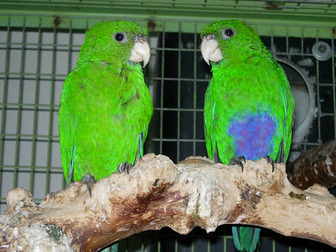Purple-bellied Parrot
It is a relatively long-tailed parrot with a total length of c. 28 cm .

Original source: TJ LinPermission(Reusing this file)This image, which was originally posted to Flickr.com, was uploaded to Commons using Flickr upload bot on 10:55, 19 February 2009 (UTC) by Snowmanradio (talk). On that date it was licensed under the license below. This file is licensed under the Creative Commons Attribution-Share Alike 2.0 Generic license.You are free:to share – to copy, distribute and transmit the work
Author: TJ LinPermission(Reusing this file)This image, which was originally posted to Flickr.com, was uploaded to Commons using Flickr upload bot on 10:55, 19 February 2009 (UTC) by Snowmanradio (talk). On that date it was licensed under the license below. This file is licensed under the Creative Commons Attribution-Share Alike 2.0 Generic license.You are free:to share – to copy, distribute and transmit the work
The Purple-bellied Parrot is classified as Near Threatened (NT), is close to qualifying for or is likely to qualify for a threatened category in the near future.
The Purple-bellied Parrot (Triclaria malachitacea) is endemic to the coastal forest of southeastern Brazil from Rio Grande do Sul north to southern Bahia. Seasonal migrations have been observed. Habitat & Status: This species is now critically endangered due to habitat destruction by the cultivation of crops, such as tobacco and bananas. The purple-bellied parrots are now limited to an area which represents far less than 10% of their original range. More
Male Purple-bellied Parrot in captivity © Anthony Snell Wild Purple-bellied Parrot perched on palm frond © Ron Hoff Wild Purple-bellied Parrot perched on palm frond © Ron Hoff Purple-bellied Parrot © Jonker/Innemee Araproject | http://www.araproject.nl Purple-belled Parrot on branch © Luiz Claudio Marigo | http://www.lcmarigo.com.br/ingles/index. More
Wild Purple-bellied Parrot perched on palm frond Credit: © Ron Hoff photos Photos videoVideo 1 eNewsletter SIGNUP FOR EMAIL UPDATES Did You Know?The male Purple-bellied Parrot displays by walking jerkily with head lowered, pushing its beak in front of it along the perch. More
Purple-bellied Parrots are particularly fond of strawberries, oranges, grapes, green beans and corn. Five Purple-bellie chicks were successfully raised in 1992. Shown here shortly after weaning at about 10 weeks old. Purple-bellies are particularly fond of strawberries, apples, oranges, grapes, green beans and corn. The first signs of breeding activity were noticed in early February 1992 when the breeding pairs were approximately three years old. More
These two young Purple-bellied Parrots were paired together, forming the first unrelated domestically bred pair. Since these Purple-bellied Parrot babies were being kept for breeding stock, they were not handled in a way which would make pets of them, never the less they displayed a great affection, curiosity, playfulness, and the ability to speak. As I feed each day I am greeted through the high pitched squeals of delight, “Hi guys, what’cha doing. More
Purple-bellied Parrot (Triclaria malachitacea) A parrot found in southeast Brazil and north to south Bahia. Mountain parrot of the costal areas. The adults are dimorphic with the male having the destinctivepurple belly. Immatures do not normally have the purple coloured belly.Noe regarded as very endangered in the wild. In aviculture known as a quiet parrot with a melodic call similar to a thrush. Occasionally seen in collections where they are known as active flying parrots given spacious aviary's. More
* Purple-bellied Parrot information Se ogs More
Family : Psittacidae
Genus : Triclaria
Species : malachitacea
Authority : (Spix, 1824)

